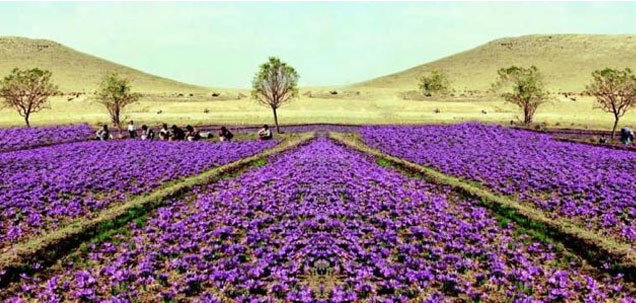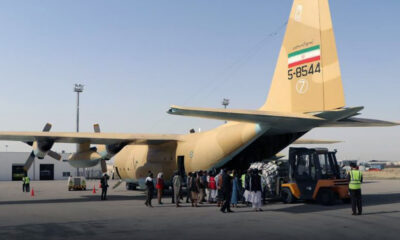Latest News
Sharp rise in Saffron cultivation

Afghanistan Ministry of Agriculture said that Saffron cultivation has a remarkable increase compared to the last year.
According to officials in the ministry of agriculture, more than four hundred formers all across the country have been trained how to cultivate and collect Saffron.
They consider distributing the bushes of Saffron in weight of 116 tones to all farmers across the country.
They noted that last year, of the 24 provinces of the country four thousand kilograms of Saffron have been collected and the figure may have a high increase this year.
“In addition to Herat province, the quality of Saffron has also become better in Balkh province,” Lutfullah Rashid, spokesman of agriculture ministry said.
According to the National Union of Saffron Growers (NUSG), Herat Province currently produces more than 90 percent of Afghanistan’s saffron although farmers in 25 other provinces grow it too. More than 6,000 Herati farmers grow saffron and some 18 companies sell and export it abroad.
Saffron production reaches 3 tons annually in this province, 60-80 percent of which is exported. NUSG’s data also show saffron cultivation is more prevalent in Ghoryan, Pashtun Zarghoon, Enjil and Gozara compared to other districts in Herat Province.
Saffron production in Afghanistan dates back to more than 100 years. But saffron cultivation was forgotten until some 22 years ago when some Afghans who had been acquainted with saffron cultivation and production in Iran returned and decided to continue the practice in Ghoryan district in Herat Province.
This trend, which started with 60 square meters of land, moved so fast that now more than 800 hectares of land in Herat are under saffron cultivation.

Latest News
Russian and Uzbek presidents emphasize need for stability in Afghanistan

The Presidents of Russia and Uzbekistan this week discussed the issue of Afghanistan and emphasized the need for peace and stability in the country.
TASS News Agency reported that Vladimir Putin and Shavkat Mirziyoyev highlighted this in a joint statement during the Russian President’s visit to Uzbekistan.
“The leaders of the countries prioritize achieving peace and stability in Afghanistan as a factor influencing the security of Central Asia and neighboring regions,” the statement read.
Both countries “intend to coordinate their efforts within the framework of the Moscow format, the Shanghai Cooperation Organization, and other mechanisms to achieve concrete results in resolving the situation in Afghanistan.”
They also assessed the first session of the working group on the development of the Belarus-Russia-Kazakhstan-Uzbekistan-Afghanistan-Pakistan transport corridor.
Putin visited Uzbekistan this week and reportedly signed an agreement with his Uzbek counterpart to establish a “small nuclear power plant.”
According to the Associated Press, Russia will build this plant – Central Asia’s first since the Soviet Union’s collapse.
Latest News
Government sells 60,000 tons of Qashqari oil for $33 million

The Ministry of Mines and Petroleum on Tuesday announced that it has sold 60,000 tons of crude oil extracted from Qashqari wells in Sar-e-Pul province for around $33 million.
A total of 18 companies participated in the bidding ceremony held on Tuesday.
In the ceremony, Acting Minister of Mines and Petroleum Shehabuddin Delawar said that if the contracted company performs better, extraction of oil in Qashqari will increase to 3,000 tons per day.
Delawar said that some foreign companies are interested in investing in the oil sector in Afghanistan.
“Let’s work hard and extract oil. God has brought security, Islamic system and transparency,” he said.
Officials of the winning company said that they will refine the purchased oil inside the country, noting that it will create job opportunities for locals.
Currently, more than 1,000 tons of oil are extracted from 24 oil wells in Qashqari.
Latest News
About 6.5 million children in Afghanistan will ‘face crisis levels of hunger’ this year

An estimated 6.5 million children in Afghanistan – or nearly three out of ten – will face crisis or emergency levels of hunger this year as the country feels the immediate impacts of floods, the long term effects of drought and the return of Afghans from Pakistan and Iran, said Save the Children in a statement this week.
New figures forecast that 28% of the population – or about 12.4 million people – will face acute food insecurity before October. Of those, nearly 2.4 million are predicted to experience emergency levels of hunger, which is one level below famine.
The figures show a slight improvement from the last report in October 2023, but underline the continuing need for assistance, with poverty affecting one in two Afghans.
Torrential rain and flash floods this month in Northern Afghanistan have killed more than 400 people, destroyed or damaged thousands of homes and turned farmland to mud.
Children in the flood hit areas have limited access to clean water, with some reporting stomach problems, Save the Children said.
In addition, an estimated 2.9 million children under the age of five are projected to suffer from acute malnutrition in 2024.
Dr Nawid who works for a Save the Children health team in Northern Afghanistan said: “These people face financial problems. From an agricultural standpoint, they have land but don’t have water or adequate land for farming – they are jobless. These things affect children.
“When children are affected, they may not be able to go to school or may become busy working to find food for their homes. They become deprived of their rights or become ill and malnourished. All these problems are affecting children.”
The slight improvement in the numbers of children expected to experience acute hunger is linked to widespread humanitarian assistance and a projected improved harvest, among other factors – but food aid will decline this year due to funding cuts.
-

 Regional5 days ago
Regional5 days agoIran’s Raisi buried in Mashhad as mourners pack Iranian holy city
-

 Latest News5 days ago
Latest News5 days agoAircraft fuel not imported to Afghanistan since last month: ACCI
-

 Latest News4 days ago
Latest News4 days agoIran’s aid package for flood victims arrives in Balkh
-

 Latest News5 days ago
Latest News5 days agoFloods leave 15 dead in Faryab, Sar-e-Pul provinces
-

 Regional5 days ago
Regional5 days agoPakistan to pay $2.58 million in compensation to families of 5 Chinese killed in suicide attack
-

 Latest News4 days ago
Latest News4 days agoNASA, Boeing clear two technical hurdles for Starliner’s debut crew flight
-

 Latest News5 days ago
Latest News5 days agoMcCaul stresses pressuring IEA to lift bans on Afghan women and girls
-

 World4 days ago
World4 days agoWorld Court orders Israel to halt assault on Gaza’s Rafah















